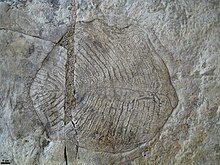Yorgia
| Yorgia Temporal range: Ediacaran
| |
|---|---|

| |
| Fossil of Yorgia waggoneri | |
| Scientific classification | |
| Kingdom: | |
| Phylum: | |
| Family: | Yorgiidae
|
| Genus: | Yorgia
|
| Species: | Y. waggoneri Ivantsov, 1999[1]
|
Yorgia waggoneri is a discoidal Ediacaran, resembling a cross between the organisms Dickinsonia and Spriggina. It has a low, segmented body consisting of a short wide "head", no appendages, and a long body region, reaching a maximum length of 25 cm (9.8 in). It is classified into an extinct animal phylum, the Proarticulata.[2]
Etymology
The generic name Yorgia comes from the Yorga river on the Zimnii Bereg (Winter Coast) of the White Sea, where the first specimens were found. The specific name in honor of U. S. paleontologist Ben Waggoner, who found the first specimen.
Morphology

The body plan of the Yorgia and other proarticulates is unusual for solitary (non-colonial) metazoans. These bilateral organisms have a segmented metameric body, but left and right transverse elements (isomers) are organized in an alternating pattern relatively to the axis of the body – they are not direct mirror images. This phenomenon is described as the symmetry of gliding reflection, which is a characteristic also found in the similar Spriggina. Some proarticulates (Yorgia, Archaeaspinus) demonstrate obvious asymmetry of left and right parts of the body. Yorgia’s initial right isomer is the only one which spreads far towards the left side of the body. [2] [3] This lack of true bilateral symmetry, along with other considerations, has led some scientists to suspect that the organism falls in a sister group to the eumetazoa (i.e. all animals except Parazoa).[4]
Fossil record
Imprints of the Yorgia waggoneri has been found in the rocks of Vendian period (Ediacaran) White sea region of Russia, dated around 555.5 Ma. and Yorgia sp. has been found in the Central Urals [5] of Russia and Flinders Ranges, Australia.[6] Most body imprints of Yorgia have in the past been primarily preserved on the sole of sandstone beds in negative relief. Other Yorgia fossils show internal structure in the original organism, showing two symmetrical rows of nodules, a central tube, rib like tubes, and a semicircular shape with a hole in the circle centre positioned towards the head end. This structure has been interpreted as the impression of gonads, intestine and mouth.[verification needed]
Trace fossils

Some fossils appear as chains of positive imprints (the ichnospecies Epibaion waggoneris), terminated by the negative imprint of the animal. Such positive imprints are confined to the "elephant skin" surface texture that is interpreted as the remains of a microbial film. They have been interpreted as the feeding tracks produced as Yorgia fed on the surface of the microbial mat that lined the sea floor. Grazing of that bacterial film could have been accomplished by the work of numerous hair-like organs, cilia, located on the ventral side of the body, which caught and transported particles of the food substrate into the special elongated pockets arranged on the borders between the isomers. Chevron-like marks on the positive imprints has been taken as evidence of this cilia activity.[3]
[7] This feeding habit is unknown in post-Ediacaran deposits.[8]
Taphonomic details revealed in Yorgia allow interpretation of the chains of positive imprints of other proarticulates as grazing traces, as opposed to trails created as organisms were swept along the sea floor by currents. In addition to Yorgia, two fossil taxa, Epibaion and Phyllozoon, seem to have produced similar grazing traces. Small groups of positive body imprints are documented for Dickinsonia costata as well and Dickinsonia cf. tenuis.[7][9]
See also
References
- ^ Ivantsov, A.Y. (1999). "A New Dickinsonid from the Upper Vendian of the White Sea Winter Coast (Russia, Arkhangelsk Region)". Paleontological Journal. 33 (3): 233–241.
- ^ a b Ivantsov, A.Y. (2001). "Vendia and Other Precambrian "Arthropods"". Paleontological Journal. 35 (4): 335–343.
- ^ a b Ivantsov, A.Y. (2004) "Vendian Animals in the Phylum Proarticulata". The Rise and Fall of the Vendian Biota. IGSP Project 493. Abstracts. Prato, Italy, p. 52. Cite error: The named reference "Ivantsov2004" was defined multiple times with different content (see the help page).
- ^ Buss, L.W. and Seilacher, A. (1994). "The Phylum Vendobionta: A Sister Group of the Eumetazoa?". Paleobiology. 20 (1): 1–4. ISSN 0094-8373. JSTOR 2401145.
{{cite journal}}: CS1 maint: multiple names: authors list (link) - ^ Grazhdankin D. V. (2005). "The Ediacaran White Sea Biota in the Central Urals". Doklady Earth Sciences. 401 (6): 784–788.
{{cite journal}}: Unknown parameter|coauthors=ignored (|author=suggested) (help) - ^ Droser, M. (2006). "Assemblage palaeoecology of the Ediacara biota: The unabridged edition?" ([dead link] – Scholar search). Palaeogeography, Palaeoclimatology, Palaeoecology. 232 (2–4): 131–147. doi:10.1016/j.palaeo.2005.12.015.
{{cite journal}}: External link in|format=|coauthors=ignored (|author=suggested) (help) - ^ a b Ivantsov, A.Y. (2002). "Giant Traces of Vendian Animals" (PDF). Doklady Earth Sciences. 385 (6): 618–622.
{{cite journal}}: Unknown parameter|coauthors=ignored (|author=suggested) (help) - ^ Ivantsov, A. Yu. (2011). "Feeding traces of proarticulata—the Vendian metazoa". Paleontological Journal. 45 (3): 237–248. doi:10.1134/S0031030111030063. ISSN 0031-0301.
- ^ Retallack, G.J. (2007). "Growth, decay and burial compaction of Dickinsonia, an iconic Ediacaran fossil" (PDF). Alcheringa: an Australasian Journal of Palaeontology. 31 (3): 215–240. doi:10.1080/03115510701484705.
- Dzik, Jerzy (2003). "Anatomical Information Content in the Ediacaran Fossils and Their Possible Zoological Affinities" (PDF). Integrative and Comparative Biology. 43 (1): 114–126. doi:10.1093/icb/43.1.114. PMID 21680416.
- Fedonkin, M. A. (2003) "The origin of the Metazoa in the light of the Proterozoic fossil record" Paleontological Research, vol. 7, no. 1, pp. 9–41.,
